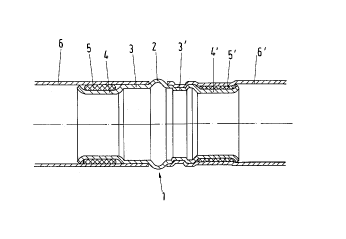Note: Descriptions are shown in the official language in which they were submitted.
CA 02232417 1998-03-18
Pipe Conr~ctQr
FILE, ~!~ THIS A~!ENDED
r)escription ~T T~AN~-~L~ J
The invention relates to a pipe connector in accordance with the generic part of the main
claim.
A generic pipe conn~ctor from the Geberit Company is known (see excerpt from colnpany
brochure). In this system, a so~a~led compound pipe is slipped onto a red brass fitting. The
compound pipe comprises an inner pipe with an aluminum mantle, which transports the
liquid, and a sleeve pipe that provides external protection and is located over the inner pipe.
Usually, the inner pipe and the sleeve pipe are made of plastic. The fatting has an elongated
region ~vith a stop, up to which the pipe to be conn~ted is slipped. The region adj~cent to
the stop usually has two ring grooves, in each of which is arranged a sealing ring. The
rem~in;ng section is sharply contoured, so that the slipped-on pipe can be shaped into the
contour during pressing. After the pipe is slipped on, pressing tongs are applied ~rom the
outside and the pipe is pressed on in the sealing ring region as well as the contoured region.
The sealing ring region thereby carries out the sealing function, while the contoured region
is responsible for axial locking. It is disadvantageous in this system that the compound pipe
can be used only for a narrow temperature and pressure range. E;urthermore, the fitting is
expensive to produce, because the contoured end regions as well as the sealing ring region must
be manufactured with precision. Another disad-vantage is the crevice that remains between the
slipped-on pipe and the contoured region of the fitting. Aggressive subst~nc~s dissolved in
liquid can penetrate into this crevicej by repeated evaporation, their concentrations can
increase disproportionately and, in the worst case, lead to so~alled crevice corrosion.
CA 02232417 1998-03-18
The object of the invention is to in~jcate a pipe connector of the generic type that is also
suitable for higher pressures and temperatures and in which the development of crevice
corrosion is avoided. This object is attained by means of the features indicated in the
characterizing part of the main claim. Advantageous further developments are the subject
matter of the subclaims.
In the pipe connector according to the invention, advantageously, the required position of the
pipe slipped onto the fitting can be im~e~iat-o~ y recogni7~d visually without other aids. The
long-proven metal ~res~ure connection achievecl by deforming the pipe and fitting is reta-ned~
so that high axial longitudinal forces and thus high internal pressures can be transmitted. The
transition between the pipe and the fitting is free of crevices, because the sealing ring is
arranged in the end region of the fitting.
Advantageously, the stop is embodied as a roof-shaped bulge, because this can be simply
produced witk pressing m~chi~es. The radial depth of the flat recess for the sealing ring
should be as small as possible, because this constitutes the cross-section-determined bottleneck
of the conduit pipe system. To lessen this problem, it is also proposed that the internal
ter of the pipe be enlarged in the slipped-on region, so that the cross-section of the pipe
section attached thereto corresponds roughly to the internal ~ mPter in the sealing region of
the f1tting. In this way, pressure losses in the connection region are largely avoided.
The pipe connector according to the invention iis described in greater deta;l in reference to two
examples. The drawings show:
Figure 1 A longitudinal section through a first embodiment of the pipe connectoraccording to the invention;
l:iigure 2 Like ~igure 1, but a different embodiment.
Figure 1 shows, in longitudinal section, a first embodiment of the pipe connector according
to the invention. The left part of the drawing shows the pipe connector in the slipped-on
state. The right part of the drawing shows the pipe connector after pressing. The core of the
connection is a fitting 1,
CA 02232417 1998-03-18
which has a StOp 2 embodied as a bulge that extends radially outward. Attached thereto, at
least toward one side, is a cylindrical section 3, 3' that extends in the longitudinal direction
and then goes over into a section having, for ~example, a flat recess 4, 4'. Arran3~ed in this
recess 4, 4' is a sealing ring j, 5'. In this example, two smooth-ended conduit pipes 6, 6' are
slipped onto the fitting 1, specifically, up to the stop 2. By means of a pressing tool (not
shown here~, the two pressing points are deforrned one after the other. As mentioned above,
the right part of the dra~ing shows the pressed state. The deformed section 3' thereby
undertakes the axial locking of the pipe connector, while the section 4' performs the sealing
function. In section 3', both the slipped-on pipe 6' and the fitting section 3' located below
the pipe 6' are de~ormed. The type of pressing-in, e.g., hexagonal or lemon-shaped segmen~s,
depends on the contour of the mouth of the pressing jaws (not shown here).
Figure 2 shows a second embodiment, which uses the same reference numbers as in Figure 1
for the same parts. Again, the left part of the drawing shows the pipe connector in the
slipped-on state, while the right part of the drawing shows the pressed state. The fitting 1,
in geometry and shape, is the same as in Figure 1. The pipe end sections are designed
differently. The smooth-ended pipes 7, 7' have an expanded section 8, 8' in the sli~on region
on the fitting 1. The section 8, 8' is selected in such a way that the internal diameter 9, 9' of
the actual conduit pipe 7, 7' corresponds roughly to the intér~al diameter 10, 10' of the fitting
1 in the sealing region. Thus, pressure losses are largely avoided in the connection region.
